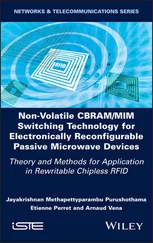Joel P. Dunsmore - Handbook of Microwave Component Measurements
Здесь есть возможность читать онлайн «Joel P. Dunsmore - Handbook of Microwave Component Measurements» — ознакомительный отрывок электронной книги совершенно бесплатно, а после прочтения отрывка купить полную версию. В некоторых случаях можно слушать аудио, скачать через торрент в формате fb2 и присутствует краткое содержание. Жанр: unrecognised, на английском языке. Описание произведения, (предисловие) а так же отзывы посетителей доступны на портале библиотеки ЛибКат.
- Название:Handbook of Microwave Component Measurements
- Автор:
- Жанр:
- Год:неизвестен
- ISBN:нет данных
- Рейтинг книги:5 / 5. Голосов: 1
-
Избранное:Добавить в избранное
- Отзывы:
-
Ваша оценка:
- 100
- 1
- 2
- 3
- 4
- 5
Handbook of Microwave Component Measurements: краткое содержание, описание и аннотация
Предлагаем к чтению аннотацию, описание, краткое содержание или предисловие (зависит от того, что написал сам автор книги «Handbook of Microwave Component Measurements»). Если вы не нашли необходимую информацию о книге — напишите в комментариях, мы постараемся отыскать её.
Handbook of Microwave Component Measurements — читать онлайн ознакомительный отрывок
Ниже представлен текст книги, разбитый по страницам. Система сохранения места последней прочитанной страницы, позволяет с удобством читать онлайн бесплатно книгу «Handbook of Microwave Component Measurements», без необходимости каждый раз заново искать на чём Вы остановились. Поставьте закладку, и сможете в любой момент перейти на страницу, на которой закончили чтение.
Интервал:
Закладка:
As the focus of this book is stimulus/response measurements, the measurement of oscillators will not be covered.
1.15 Measurement Instrumentation
1.15.1 Power Meters
Perhaps the simplest and most common of microwave instruments is the power meter. It consists of a sensor, which absorbs or detects RF power and converts it to a DC signal, and measurement circuitry, which accurately measures this DC signal and applies correction and calibration factors to it, to produce a reading of the RF power level. Power meters come in a variety of forms and complexities, some of which are noted next.
1.15.1.1 Calorimeters
Often considered the most accurate and traceable of power measurement systems, the calorimeter consists of a thermally isolated RF load that absorbs the RF energy. This load is kept in a heat exchanger, and a thermopile is used to sense the change in temperature. Since the fundamental measurement is temperature, the traceability of these systems to fundamental SI units is good. These systems can handle large power but are slow to respond, are heavy, and are typically not used by practicing RF engineers, except in special cases.
1.15.1.2 RF Bolometers and Thermistor
An RF bolometer or thermistor is a system where the RF measuring element is a thermally sensitive resistor used as part of a DC bridge system. The DC bridge is electrically balanced, and when an RF signal is applied to the bolometer element, the element heats and its DC resistance changes. The DC bridge is nulled using an offset voltage, and the measure of the offset voltage can be related directly to the power absorbed by the bolometer. The key aspect of the bolometer is that it is equally sensitive to RF or DC power; thus, a precision DC source can be used to produce a known power at the bolometer, and the balancing circuit is thus calibrated relative to the DC power absorbed. The heating effect of the RF power produces the same offsets as the DC power and thus is easily calibrated. Bolometers have a relatively small dynamic range (the range of input powers over which they operate) but have linearity (the ability to correctly measure differences in input power) derived from a bridge circuit using DC substitution. Typically, bolometers are found only in precision metrology laboratories and are not in common use among RF engineers.
1.15.1.3 RF Thermocouples
Until recently, RF thermocouples were the most common type of power sensor used. These thermocouples convert heating directly into a DC voltage and, because their small size and thus small thermal mass, are much faster responding and have a larger dynamic range than either thermistors or calorimeters. As with other sensors, these require calibration with a precision source but are typically DC blocked, so the source must be a low‐frequency AC source. These sensors are commonly used throughout the RF industry but have the detriment of being somewhat slow‐responding (with response times in the several to tens of millisecond range), but they are extremely linear and relatively non‐responsive to harmonics. That is, harmonic power will be detected as an RMS error of the power of desired signal. Since harmonics 20 dBc or lower represent less than 1% of the power of the main signal, the error due to harmonics is quite low.
1.15.1.4 Diode Detectors
For modern power meter applications, the diode or multi‐diode power sensor is often the preferred choice. These sensors employ one or more diodes that rectify the RF signal and produce an equivalent DC signal. Occasionally, the DC signal is “chopped” or modified in such a way as to produce a square wave to the measurement portion of the power meter, typically a precision analog‐to‐digital converter (ADC). Chopping the signal helps compensate for DC offsets in the ADC input.
Older diode detectors used only a single diode, and the top 20 dB of the detector range was often described as the “linear” range; below that range, the diode would operate in “square‐law” mode where the output voltage would be a function of the square of the input RF signal. In the low‐power range, the output voltage would be linearly related to the square of the input voltage of the RF signal, thus be linearly proportional to the detected power. In such a region, they operated almost as well as the thermistor sensors but with much faster speeds and much wider dynamic range. At the top of their measurement range, in the linear region, the output circuitry and measurement algorithms are adjusted to compensate for the change to the linear mode of operation. However, in the linear mode, the power in the harmonics has a much greater effect, and a 20 dBc harmonic signal can have up to a 10% change in the measured power of the fundamental, even though it contains only 1% of the power. This is due to the peaking effect that the harmonic can have on the RF voltage. Out of the square‐law region (also known as the linear region , which is in fact where the power meter is not as linear in the usual sense of the word), the power meter may not give accurate readings for complex modulated signal or signal with high harmonic content or high peak‐to‐average envelope power.
More modern diode sensors use a multitude (two or more) of embedded diode elements, some of which are padded with larger attenuation to allow them to operate at higher powers and still be in the square‐law region. Complex algorithms in the power meter instrumentation detect when the power from one sensor exceeds the square‐law region and change to take their readings for power from one of the attenuated diodes. This extends the useful range of the power sensor over more common older diode sensors.
1.15.2 Signal Sources
1.15.2.1 Analog Sources
While not a measurement instrument in their own right, signal sources or signal synthesizers, or simply sources, are used as accessory equipment in a variety of measurement tasks. They can provide CW signals in place of a mixer LO or provide an input signal to an amplifier or filter. These are typically called analog sources , and their key attributes are frequency range, output power range (minimum and maximum), phase noise and spectral purity, and frequency switching speed.
While the first two attributes are obvious, the phase noise and spectral purity are key attributes when making measurements close to the carrier such as IMD measurements or when making other distortion measurements such as harmonics.
Switching speed becomes important in automated test systems (ATSs) when using the source as a swept frequency stimulus. Commonly, stand‐alone signal sources make a trade‐off between lower‐phase noise and slower switching speeds.
1.15.2.2 Vector Sources
Another class of signal sources are vector signal generators, which have an internal I/Q modulator that allows an almost infinite variety of signals to be created. Some of these vector sources (also called digital sources because they can create signals using digital modulation techniques) have built‐in arbitrary‐waveform generators (AWGs, or arbs in the vernacular), while others have broadband I/Q inputs to allow external AWGs to drive their vector modulators directly.
With vector sources, the AWGs can be used to create a wide variety of signals including extremely fast switching CW sources (within the bandwidth of the I/Q modulator), two‐tone or multitone signals, pseudo‐random noise waveforms, and complex modulated signals following the formats used in digital communications and cellular phones.
Some key attributes of vector sources are the modulation bandwidth of the I/Q inputs, the modulation bandwidth or speed of the arbitrary waveform generator (if it is built‐in), the memory of the AWG (which affects the length of signals that can be created), and the I/Q fidelity or linearity of the modulator. This linearity limits the ability of the vector source to produce clean signals. For example, a two‐tone signal can be created by doing a double sideband suppressed carrier modulation, but if there is imbalance or non‐linearity in the modulator, there will be carrier leakage between the two tones.
Читать дальшеИнтервал:
Закладка:
Похожие книги на «Handbook of Microwave Component Measurements»
Представляем Вашему вниманию похожие книги на «Handbook of Microwave Component Measurements» списком для выбора. Мы отобрали схожую по названию и смыслу литературу в надежде предоставить читателям больше вариантов отыскать новые, интересные, ещё непрочитанные произведения.
Обсуждение, отзывы о книге «Handbook of Microwave Component Measurements» и просто собственные мнения читателей. Оставьте ваши комментарии, напишите, что Вы думаете о произведении, его смысле или главных героях. Укажите что конкретно понравилось, а что нет, и почему Вы так считаете.












